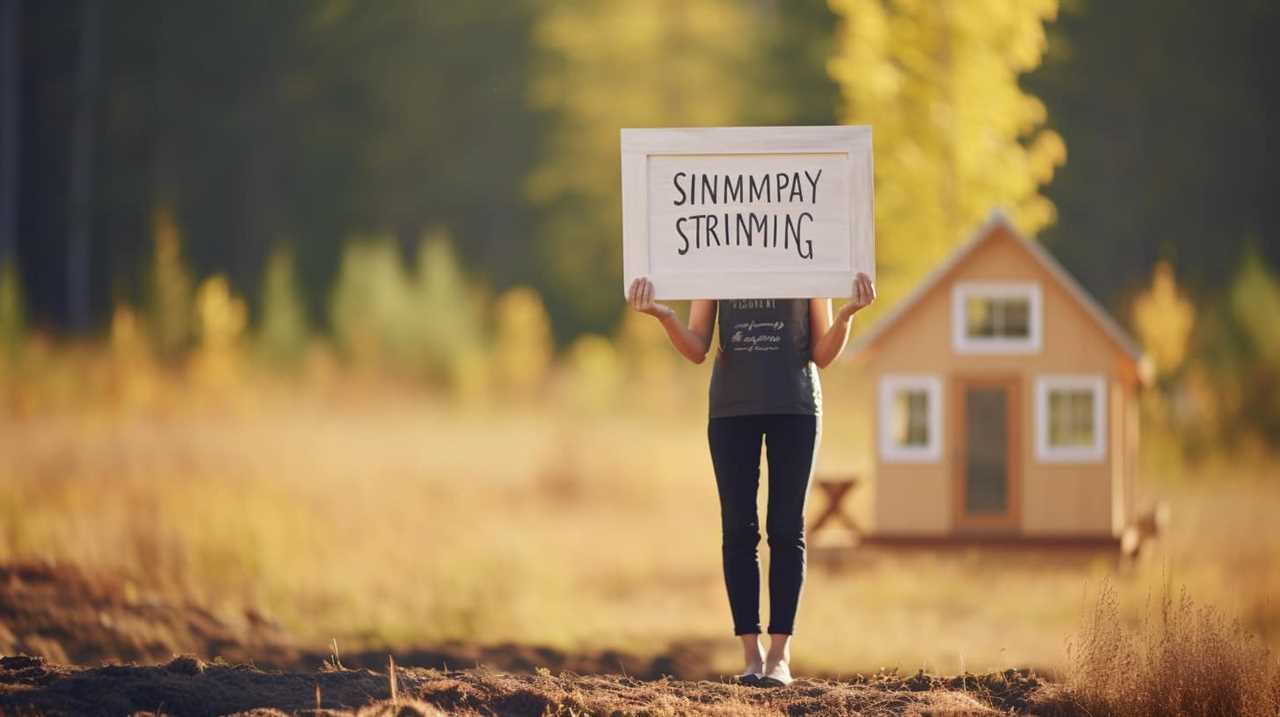As someone who owns a tiny house on wheels, I know the struggles of finding water while traveling. But don’t worry, fellow travelers! In this article, I will provide useful tips to help you maintain a reliable water source for your tiny home.
From different storage options to connecting to a water supply and even collecting rainwater, I’ve got you covered.
So, let’s dive in and discover the secrets to keeping your wheels turning with a reliable water source.
Key Takeaways
- There are various water storage solutions available for tiny houses on wheels, including portable water tanks and underfloor water tanks.
- Connecting to a water supply can be done by using a water hose and pressure regulator for city water or installing a water pump for drawing water from a nearby source.
- Rainwater collection systems can be designed to reduce reliance on municipal or well water by collecting rainwater from a collection surface like a roof and directing it into a storage tank.
- Portable water filtration options, such as gravity water filters and UV water purifiers, can be used to ensure clean and safe drinking water in a tiny house on wheels.
Types of Water Storage Solutions
I’ve researched and found various types of water storage solutions for my tiny house on wheels. When it comes to water tank options, there are a few choices that are suitable for small spaces.

One option is a portable water tank, which can be easily stored and transported. These tanks come in different sizes, allowing you to choose the one that fits your needs.
Another option is an underfloor water tank, which is installed beneath the tiny house. This type of tank maximizes space and keeps the water out of sight.
As for plumbing options, you can consider a gravity-fed system, which relies on gravity to move water from the tank to the faucets. Alternatively, you can opt for a pump system, which uses a small pump to deliver water when needed. Both options have their benefits, so it’s important to choose the one that suits your specific needs and preferences.
Connecting to a Water Supply
Sometimes, it can be challenging to connect a tiny house on wheels to a water supply, but with the right tools and knowledge, it’s possible to do so.

Here are some practical steps to help you connect your tiny house to a water supply:
-
Connecting to city water: If you have access to city water, you can connect your tiny house using a water hose. Make sure to use a pressure regulator to prevent any damage to your plumbing system.
-
Installing a water pump: If you don’t have access to city water, you can install a water pump to draw water from a nearby source such as a well or a stream. Ensure that the pump is compatible with your plumbing system and follow the manufacturer’s instructions for installation.
-
Ensuring proper filtration: It’s essential to install a water filtration system to remove impurities and ensure clean water for drinking and everyday use. Choose a filtration system that suits your needs and consider regular maintenance to keep it functioning optimally.

-
Considering water conservation: In a tiny house, water conservation is crucial. Install low-flow fixtures, such as faucets and showerheads, and practice mindful water usage to minimize waste.
Connecting your tiny house to a water supply can be a straightforward process with the right tools and techniques. However, if you prefer a more sustainable approach, you can explore rainwater collection systems as an alternative water source.
Rainwater Collection Systems
When it comes to collecting water in a tiny house on wheels, one option to consider is setting up a rainwater collection system. Rainwater harvesting has several benefits, making it an efficient and sustainable solution.
Firstly, it allows you to reduce your reliance on municipal water supply or well water, which can be costly and limited in availability. Additionally, rainwater is naturally soft and free from chemicals, making it ideal for various uses such as watering plants, doing laundry, or flushing toilets.

Designing an efficient rainwater collection system involves a few key considerations. Firstly, you’ll need a collection surface, such as a roof, to funnel the rainwater into a storage container. It’s important to ensure that the roof material is safe for potable water, especially if you plan on using the collected water for drinking or cooking.
Next, you’ll need gutters and downspouts to direct the water into the storage tank. It’s crucial to properly size the gutters and downspouts based on the average rainfall in your area to ensure maximum water collection.
Lastly, you’ll need a storage tank or cistern to store and filter the collected rainwater. The size of the tank will depend on your water needs and available space in your tiny house.
Portable Water Filtration Options
There are several portable water filtration options available for ensuring clean and safe drinking water in a tiny house on wheels. Here are some compact water filters that can help in this regard:

-
Gravity Water Filters: These filters use gravity to remove contaminants and are easy to use and maintain. They’re ideal for small spaces and can provide a constant supply of purified water.
-
Portable Water Purification Tablets: These tablets are compact and lightweight, making them perfect for tiny houses on wheels. They can quickly and effectively kill bacteria and viruses, providing clean drinking water in minutes.
-
Mini Water Filters: These small filters can fit in your pocket and are designed for personal use. They can remove bacteria, protozoa, and other contaminants, ensuring safe drinking water wherever you go.
-
UV Water Purifiers: These devices use ultraviolet light to kill bacteria and viruses. They’re compact and easy to use, providing instant purification without the need for chemicals or filters.

With these portable water filtration options, you can have peace of mind knowing that you have access to clean and safe drinking water in your tiny house on wheels.
Now, let’s move on to some tips for water conservation in a tiny house on wheels.
Tips for Water Conservation in a Tiny House on Wheels
To maximize water usage in my tiny house on wheels, I rely on both a rainwater collection system and a water recycling system.
These two plumbing solutions help me conserve water and reduce waste.

The rainwater collection system allows me to capture and store rainwater, which I can then use for various purposes such as flushing the toilet, watering plants, or even taking a quick shower.
This not only helps me save on my water bills but also reduces my environmental impact.
Additionally, I’ve installed a water recycling system that treats and filters the greywater from sinks and showers, allowing me to reuse it for non-potable purposes.
This way, I can make the most out of every drop of water and ensure sustainable water usage in my tiny house on wheels.

Frequently Asked Questions
Can I Use a Water Heater in My Tiny House on Wheels?
Yes, I can use a water heater in my tiny house on wheels. There are various water heater options available, such as propane or electric models. Additionally, alternative water sources like rainwater collection can be utilized.
How Often Do I Need to Clean and Maintain My Rainwater Collection System?
Cleaning frequency and maintenance tips for a rainwater collection system depend on various factors such as usage, location, and water quality. Regular inspection, cleaning filters, and removing debris are essential to ensure optimal performance and water quality.
Is It Possible to Have a Composting Toilet in a Tiny House on Wheels?
Yes, it is possible to have a composting toilet in a tiny house on wheels. However, it is important to research and follow composting toilet regulations and consider the plumbing requirements for a mobile home.
Are There Any Regulations or Permits Required for Connecting to a Water Supply in Different Locations?
Yes, there are regulations and permits required for connecting to a water supply in different locations. However, with proper research and planning, it is possible to navigate these requirements and ensure a reliable water source for a tiny house on wheels.

What Are the Potential Health Risks Associated With Using Portable Water Filtration Options?
When considering portable water filtration options, it’s important to be aware of the potential health risks. Some filters may not effectively remove all contaminants, so it’s crucial to research and choose a reliable option.
Conclusion
In conclusion, ensuring a steady water supply in a tiny house on wheels requires careful planning and consideration of different options.
From various types of water storage solutions to connecting to a water supply or utilizing rainwater collection systems, there are plenty of ways to meet your water needs.
Portable water filtration options can also help ensure clean and safe water.

By implementing these strategies and practicing water conservation, you can successfully navigate the challenges of living in a tiny house on wheels, just like a drop of water finding its way through a winding river.
I’m Theodore, and I love tiny houses. In fact, I’m the author of Tiny House 43, a book about tiny houses that are also tree houses. I think they’re magical places where imaginations can run wild and adventures are just waiting to happen.
While tree houses are often associated with childhood, they can be the perfect adult retreat. They offer a cozy space to relax and unwind, surrounded by nature. And since they’re typically built on stilts or raised platforms, they offer stunning views that traditional homes simply can’t match.
If you’re looking for a unique and romantic getaway, a tree house tiny house might just be the perfect option.
















